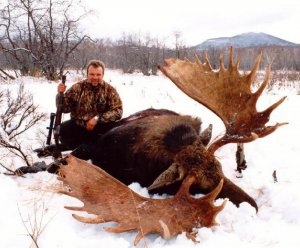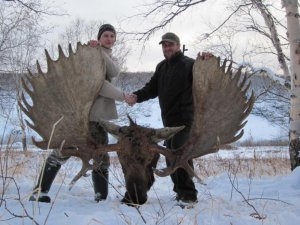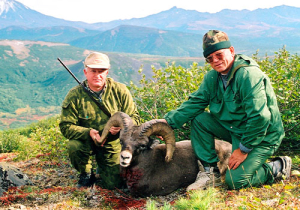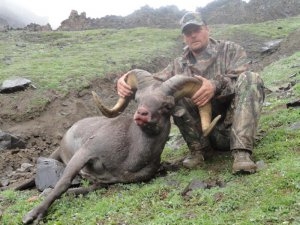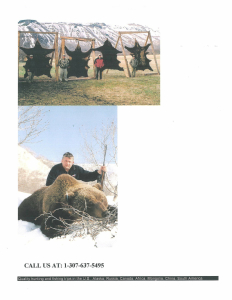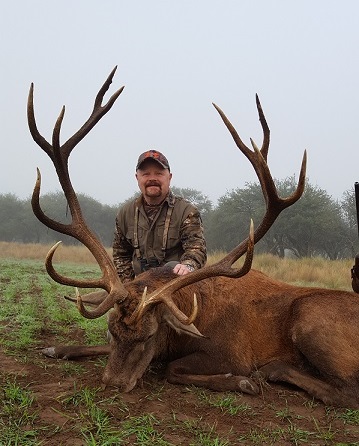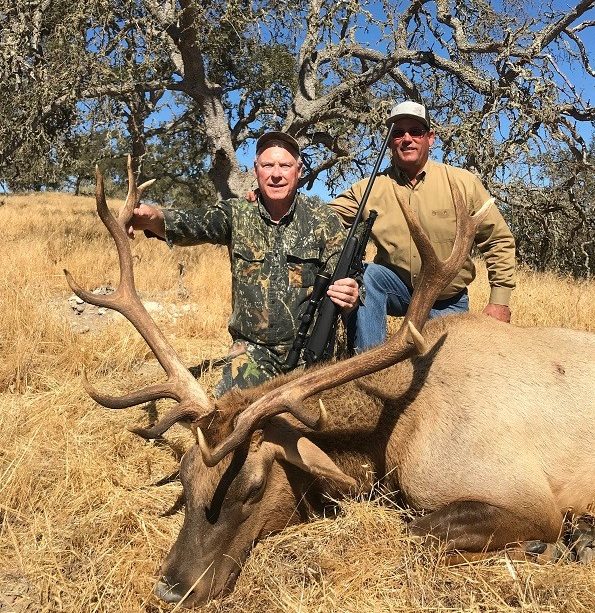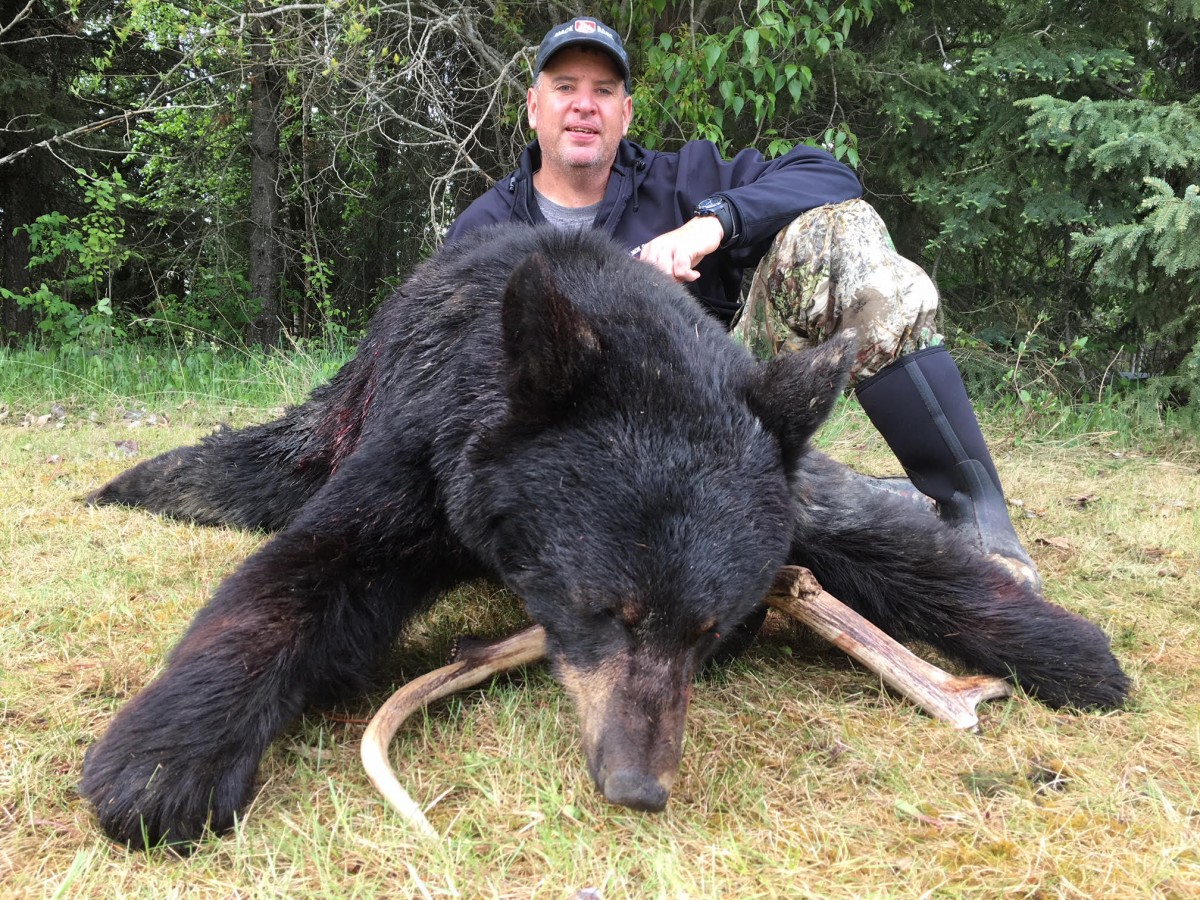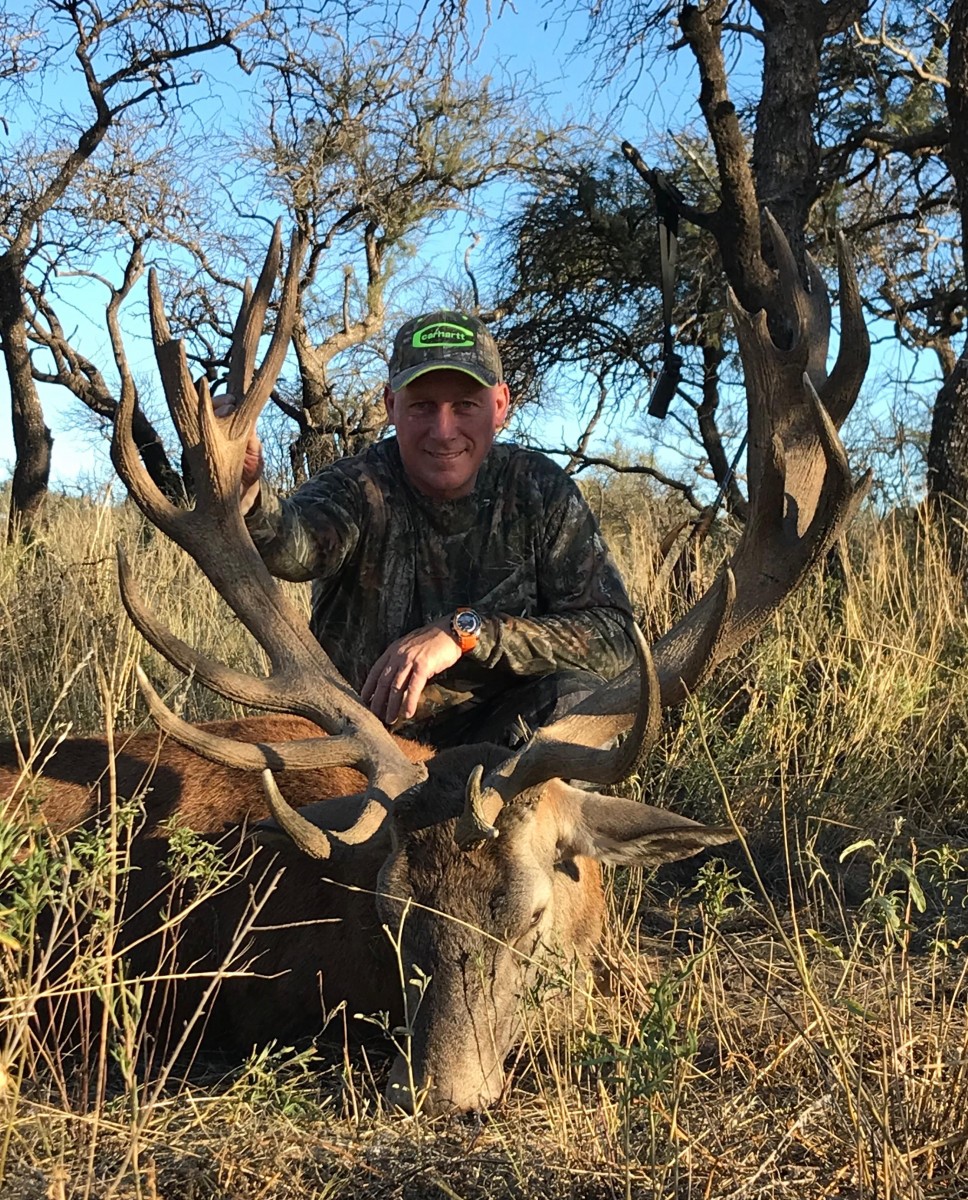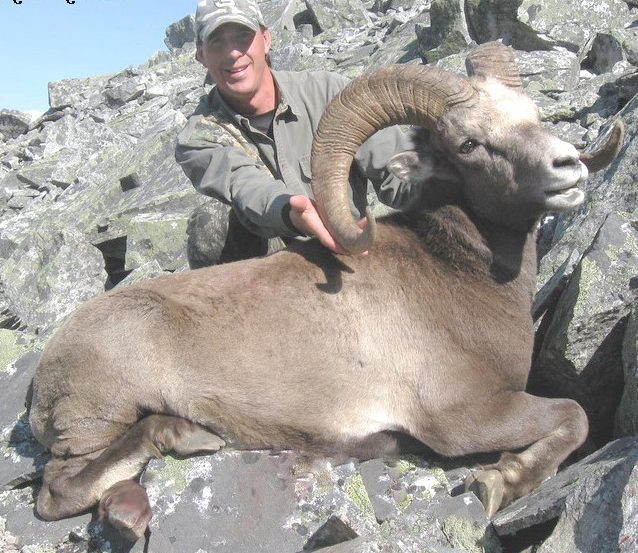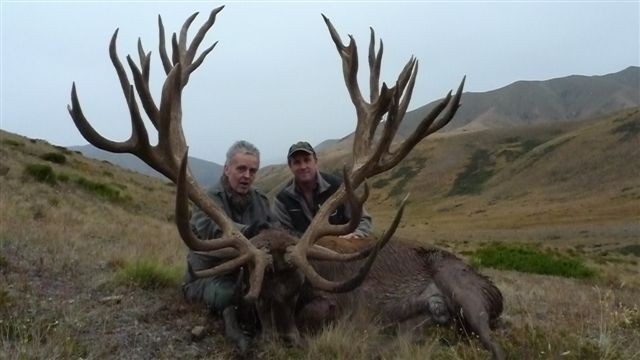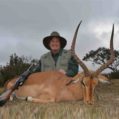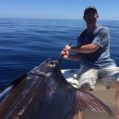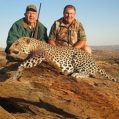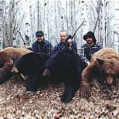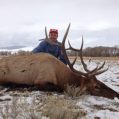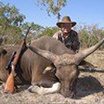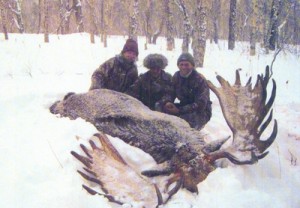
MOOSE:
This outfitter operates on the Kamchatka Peninsula where the huge Eastern Siberian moose lives. A mature trophy bull here will be around 1400 pounds or more and will have an average antler width of 62”-64”. The largest to date here has been an amazing 75”! One of our clients took a monster 72” moose on this hunt; then took another in the mid 60’s which had truly non-typical horns and was quite a sight to behold.
Moose moved into the upper mainland of the Kamchatka Peninsula thousands of years ago. However the very difficult mountain passes prevented the migration of the species into this outfitters area. In 1978 specialists of the Regional Hunting Department carried out a project transporting 45 young moose to the center of Kamchatka. These moose were brought in from the Chukotsky region, home to the largest moose on the planet. Kamchatka now regularly produces the largest trophy moose shot around the world each season. With a milder climate, less snow, and an abundance of food, those transported moose quickly bred and settled along the valley of the Kamchatka River and many other regions. The population for the past 20 years has risen to 2900 animals with some huge horns.
Success has averaged 80% and up, but that includes a few who could not walk or whose shooting was less than perfect, or weather interfered, or who wanted a 70” beast and did not get it, or who were just not lucky. A hunter who is reasonably fit and who can walk several miles or more, and who can shoot accurately – should normally have no problem in getting his trophy moose. But being in good shape is always important, especially if you travel this far. Moose hunts can test you if terrain is boggy or has lots of willows.
Hunting season is from August 20 until December 15. You can begin your hunt as early as September 15, when the rut starts. Kamchatka trophy moose respond quite well to calling and it is always very exciting when a monster bull responds to a call. Normally, you should take your trophy within a week.
Their later hunting period, late October – November demands you to be in good physical shape. After mating bulls rest in the forest and are less active. It usually takes 2 weeks to find and kill your trophy during this time period. However they may transport you on sleighs behind snowmobiles, and then a stalk on snowshoes is often done. You can cover a lot of ground this way, and our own Hunt Nation hunter with the 72” moose hunted this way.
They annually take 16-17 bulls on their hundreds of thousands of acres of territory. A mature bull will weight approximately 650 kg (1430 pounds). Racks as large as 183 cm (72 inches) have been taken, Even larger sheds have been found!
They use 3 areas for moose hunting. In one of the camps there are horses for hunting. Accommodations are in a warm cabin, with a separate kitchen. You will have an abundance of Russian home style food, cooked on a propane stove by their chef. For your comfort they also have traditional Russian saunas. Each camp has generator (220 V, 50 Amperes); satellite phones are used for communication.
The September moose hunts on a scale of 1 to 10 are probably a 7 or so in terms of physical exertion, and weather is warmer but rain is common. The November moose hunts in terms of exertion depend on snow fall. They can be more exertive or less exertive. Overal our personal clients seem to have done best on the later hunts, but expect to spend more time. Weather of course is always a factor. There are in effect, two seasons-an early season during the rut in the second half of September, and a late season from around early November until 20 December. The late hunt is a snow hunt when the bulls are in their bachelor groups and their tracks are visible, making them vulnerable. You may use snowmobiles and/or snowshoes at that time. You may ride or may be towed on a sled. This gives you an excellent ability to cover much ground looking for big moose. On the earlier fall hunt you can also add on a big Russian brown bear, from about September 15th, onward. Bear can be scarce later on.
You can also add on a Kamchatka Big Horn sheep until around September 20th. There are some excellent sheep here. Success on sheep averages around 70%, and would be higher but for hunters who turn out not to be in sheep shape! In the Spring this outfitter has taken 10’ bears, so there are some big trophies here- and he is normally close to 100% successful to boot on the big bears! We prefer Spring bear, as you see mainly trophy boars. Fall bear- see more bears, fewer trophies though.
For moose, or for a combo moose/bear hunt, expect fall temperatures in September in the 35 to 65 degree area, while in the late hunt temperatures can vary from around 32F down to perhaps a low of minus–15F. You will be fairly active so you need warm but lightweight clothing, including wind stopper type fabrics, but make sure you can stalk quietly (no noisy garments), as shots can be very close in the winter willows. If you are in a sleigh, then warm clothes are essential.
In terms of typical ranges expect anything from 30 yards to 300 yards. We think a minimal caliber here is a 300 Mag for moose or bear. Use heavy bullets to break bones and drop the animal quickly. If you are adding on bear we think a 300 Mag is minimal and we do not like them for these huge bears! Our personal choice is the .375 Mag- it performs!!
Since the Anchorage flights are not currently flying to Petroplavosk, we now route you thru Seoul, Korea or Moscow and then to Petropavlovsk, where you are met and assisted by your interpreter thru customs. Figure about $2300. Petro is a city of 300,000 or so-you will be shocked to see all the decaying military aircraft as you get ready to land. You will either overnight there, or else drive a few hours and then take the helicopter to the hunting cabins. They are warm and comfortable. Bring a sleeping bag and a mattress pad. They have Russian Saunas for your comfort and you will have plenty of hearty Russian food. The guides are experienced woodsmen, with most spending a major part of their lives trapping and hunting the Siberian wilds for sable, wolf and the like.
We have a complete equipment list, detailed suggestions, and all the forms to make your trip easy. Just have a current passport in good condition with at least 6 months to go on it. We walk you thru all the rest; we get your visa for you; we get your gun permits; your vet inspections and all documents to bring your animals back. There is truly no reason to be intimidated by this area of Russia-they are desperate for our funds, and are typically the warm friendly woodsmen most of us would expect to find in that type of country. Bring a small Russian dictionary-it is very helpful. Write out some key sentences and even the desired answers- so a question might have three suggested answers that the guide can point to— and you will have the translation right there handy.
We have sent dozens of people to Russia-it is a grand experience! We also like the fact that our outfitter is a relatively young and vigorous retired veterinarian, and that he is a professional and well educated person. He speaks excellent English, is very personable and honest and runs a very good operation. You will enjoy him very much!
In his area of Kamchatka, a 60” moose is very commonplace, a 65” is enough to raise eyebrows (slightly), and 70” is not wildly uncommon-but neither will everyone take a 70! We think a 60” to 64” range is fair, although a few in the high 50” range have been taken because of exceptional palms and points. Bears are typically in the 8’ to 9’ area with one occasionally larger; sheep are normally in the 34”-38” range and are gorgeously colored. Spring bear hunting is available (same price as moose)-and then for another $500 you can sometimes add on a capercaillie-a turkey like bird which is wary and a rare trophy! Success on moose and bear is normally 85% to 100%, sheep is 90% , but if you are in good shape you should do even better on all species.
FALL BEAR HUNTS (AUG 20TH START)
This sometimes takes place on the salmon’s spawning grounds — mostly before dark. We strongly recommend you have night-vision optics for fall bear hunting. You will also need some very warm thermal clothes to stay in the blinds as nighttime comes on, (at night the temperature may drop to freezing levels).
For the Fall hunting (from August 20), the bears move to the rivers if there is a good influx of spawning salmon. On the spawning creeks hunting takes place mostly during the dark from blinds. The older, smarter and larger the bear, the later he will come to the spawning grounds. We recommend having night-vision optics and sighting in your rifle at 100 yards. It is also recommended you bring warm clothes, a wind breaker, and good rain gear. Hip boots or waist high waders are necessary for both fall and spring hunting.
If the crop of the cedar nuts is good the bears prefer them to salmon often. Your hunting will be conducted in the morning and evening, by watching the trails in the cedar brush. By day the bears sleep deep in the cedars. And of course if the bears are In the berry-fields, you will see a number of animals simultaneously and can choose your trophy.
Their clients regularly take bears over 8 feet and quite often over 9 feet. 15 % of their clients take huge bears measuring 9.8 feet or larger. The size of trophies taken in the fall time is roughly the same as Spring, but Fall bears have heavier weights than the bears taken in spring.
Recommended rifle caliber — 338 magnums to 375 magnum, with a strong preference on the .375.
By day the bears feed on berries in the tundra, cedar nuts, or stay in brush. Hunts are made by stalking in the day when the temperature is about 50°F. sometimes you may sit over a trail or kill site at night using moonlight or night vision optics.
After you have taken your trophy, you may fish for rainbow, char and some species of salmon. The fishing is absolutely incredible! Their separate fishing trips run around $6000 if booked for that!
SPRING BEAR HUNTS
The spring season is from April 25 – May 25. At this time there is usually snow; and you normally will see the tracks of many trophy bears. The hunting is on a 1 x 1 guide to client ratio as are most of their hunts. You and your guide will glass for active bears in the morning and evening. During the day the animals lie in the sun on rocks and snow-free areas. The first week, after the bears come out of the den, they are less active and stay near their den; often returning into it for a rest.
Transportation to your hunting area is by snow mobile. Once you have arrived at your hunting area you will hunt on foot, skis or snowshoes. When a bear is found and its size determined, you and your guide will plan the stalk. We suggest you bring and wear plain white painters type jackets and coveralls or else white camouflage. You will stalk your bear, usually closing to a distance of 200-300 yards. We recommend calibers of at least 338 Magnum, and prefer the .375 H and H. Know where your shot hits at 300 yards, and know it very well!! You do not want a wounded bear.
After shooting your trophy, your guide will prepare the cape. He will also take measurements, and plenty of photos of you with your trophy. Most of the guides are also trappers and are experts at skinning and will gladly skin and flesh your trophy. After returning to camp they will prepare your bear for transportation.
The success of your hunt will depend not only on your professional guide, but also on your physical condition, hunting experience, patience and shooting skills. For the past 7 years this outfitter has had a 100% success rate during the spring season. Many of them have been entered into the SCI record book.
FALL KAMCHATKA BIGHORN SHEEP HUNTS:
The Kamchatka Big Horn inhabits the mountains of 5000 – 6200 feet altitude. Current populations are about 7500 animals on the peninsula. There are ALSO approximately 5500 of the Koryak Snow Sheep on the Peninsula, inhabiting slightly lower altitudes, usually 5,000 feet and less. A mature Bighorn ram weights 80 – 95 kg (176 – 210 pounds); the average length of horns is 85 -87 cm (33 – 34 inches). The age of the majority taken by this outfitters clients, is 9 years. The biggest trophies taken by his sheep hunters were a 41-inch Kamchatka BigHorn and a 39-inch Koryak Snow Sheep. Sport hunting does not threaten the population of snow sheep in Kamchatka; the main enemies of snow sheep are wolves and unusually snowy winters. The helicopter will take you to the tent camp, which is set up where our scouting has found the Rams. They do these scouting expedition before hunting with the clients begins. Accommodations in tents are comfortable, heated and comfortable. You will have an abundance of Russian homestyle food in camp. An interpreter will accompany you during your entire stay, both in the city and in the field. You will have your own experienced guide who has excellent knowledge of wild life in the area and will assist you to harvest a good trophy Snow Sheep
PRICING:
MOOSE : $15,000
BEAR -SPRING Hunts $12,000 FALL Hunts $12,000.
SPRING: 2nd bear $10,000. FALL: 2nd bear- $10,000
Capercaillie add on (Spring) $950
A COMBO FOR MOOSE AND BEAR IN FALL: $25000.
KAMCHATKA BIGHORN SHEEP : $approx. $20,000 but check with us.
KORYAK SNOW SHEEP: $25,000 min. of 3 hunters
RUSSIA VERSUS ALASKA
Comparing this to Alaska: As many of you may know, Alaskan moose are under tremendous predator and hunting pressure- but not everywhere. There are still superb moose hunts to be found. We have guys producing close to 100% in Alaska, and doing it all the time. There are some areas will outproduce Russia in terms of annual success, but few that can claim the same sizes of animals. But be aware that many areas in Alaska have been hurt by predators.
In other areas the Calf survival has been nil for a number of years! Many areas have gone or will shortly be going to draws and limited quotas. Size is down almost everywhere, as is success. And of course prices have been increasing in the better areas, such that now quality moose hunts in Alaska and the Yukon are in the $17,000 to $23,000 price range!! Weather in Alaska is a frequent problem. Add on exorbitant non-resident license fees and $750 and up for air charters, and maybe that much again to fly out meat and horns! A moose in Alaska can push $20,000 with success declining each year. Only predator control will stop this, and even then it will be years for populations of moose to regain former levels.
This Russian MOOSE hunt is several thousands of dollars less; it includes your licenses; no charter flights are required and success is comparable and size much larger than many of the Alaskan hunts!! Five important points! Moose hunts are a 2 week trip, with about 10 days of hunting. If you want a combo, we think 3 weeks is preferable, although two weeks can work. If you book 3 weeks for a combo, and tag out early, you can sometimes catch a flight a week earlier.
INCLUDED:
- All transportation from Petroplavosk and back, including helicopter.
- Airport pick up and return and assistance thru customs
- All documentation to import and export guns and game taken
- 1X1 guiding
- Caping and fleshing of trophy
- All lodging and meals, except for extra days or nights in Petro.
- Normally 9 days of hunting on a 13 day itinerary.
- An interpreter who meets you at plane and who also is in the field.
NOT INCLUDED:
- Visa processing and costs (about $250 max)
- Excess baggage charges and airline gun charges in Russia (average total of both is about $400)
- Gratuities and gifts (cigars go over well as a small gift)
- USF&W inspection fees (about $100)
- Any extra meals or hotels in Petro, or in Moscow if that is your routing.
CALL US AT 1-307-637-5495 info@hunt-nation.com
UPDATE: Best time- it is different every year. Since he is basically 80% on all his moose hunts, it does not make a huge difference, but we generally think the November hunts have averaged best success. But with very limited hunter numbers the sample is small so our stats may not mean a lot! Some years he does better early, some years later. The late moose hunts are done when bulls are clustered in bachelor groups- so find them and you have your pick! Some years those later hunts are the best hunts. Sometimes the Earlier hunts are better, and they can be vocal. Sizes- he is averaging around 63″- best sizes each year exceed 66”.
Camps: He has three camps for moose and about the same for bear. All have cabins and saunas and generators and satellite phones. Horses are sometimes used on moose. They pre-scout and where you go depends on where moose are found. Bring a sleeping bag for the cots. Waterproof bag for the sleeping bag.
Boots for bear – bring excellent quality hip boots (insulated and tight ankle fit). Also broken in walking boots- the normal hunting boots- waterproof
Other game- slim chance for a wolf. You can add on a brown bear or sheep as per my info. Fishing yes- depending on which camp. Also Spring Capercaillie are abundant in some areas ( A favorite bird with Europeans- basically similar to a giant grouse or small turkey- coal black with red on throat. Neat bird- they have guns for them.)
1X1 hunts. All permits taken care of by our organization and the outfitter. No hidden costs other than tips and extra time in a hotel if you go there early.
Interpreter in camp and outfitter speaks good English also.
Weather: Figure 30 -60 degrees in September- later hunts zero to 35. Expect some rain or snow.
I have a Russian equipment list for general guidelines. It was written for bear- works fine for moose.

